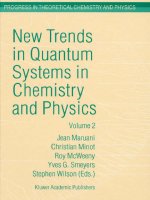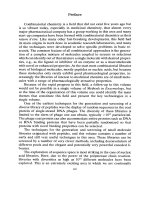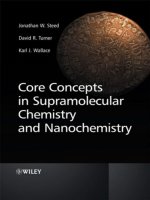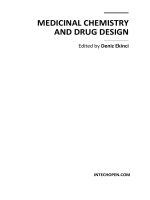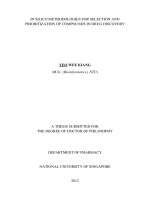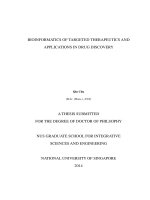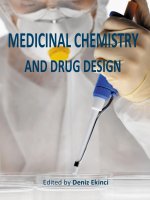Dynamic combinatorial chemistry in drug discovery bioorganic chemistry and materials science
Bạn đang xem bản rút gọn của tài liệu. Xem và tải ngay bản đầy đủ của tài liệu tại đây (15.58 MB, 275 trang )
Dynamic Combinatorial
Chemistry
Dynamic Combinatorial
Chemistry
In Drug Discovery, Bioorganic
Chemistry, and Materials Science
Edited by
Benjamin L. Miller
University of Rochester
Rochester, New York
Copyright © 2010 by John Wiley & Sons, Inc.
Published by John Wiley & Sons, Inc., Hoboken, New Jersey. All rights reserved.
Published simultaneously in Canada
No part of this publication may be reproduced, stored in a retrieval system, or transmitted in
any form or by any means, electronic, mechanical, photocopying, recording, scanning, or
otherwise, except as permitted under Section 107 or 108 of the 1976 United States Copyright Act,
without either the prior written permission of the Publisher, or authorization through payment of the
appropriate per-copy fee to the Copyright Clearance Center, Inc., 222 Rosewood Drive, Danvers,
MA 01923, (978) 750-8400, fax (978) 750-4470, or on the web at www.copyright.com. Requests
to the Publisher for permission should be addressed to the Permissions Department, John Wiley &
Sons, Inc., 111 River Street, Hoboken, NJ 07030, (201) 748-6011, fax (201) 748-6008, or online at
/>Limit of Liability/Disclaimer of Warranty: While the publisher and author have used their best
efforts in preparing this book, they make no representations or warranties with respect to the
accuracy or completeness of the contents of this book and specifically disclaim any implied
warranties of merchantability or fitness for a particular purpose. No warranty may be created or
extended by sales representatives or written sales materials. The advice and strategies contained
herein may not be suitable for your situation. You should consult with a professional where
appropriate. Neither the publisher nor author shall be liable for any loss of profit or any
other commercial damages, including but not limited to special, incidental, consequential, or other
damages.
For general information on our other products and services or for technical support, please
contact our Customer Care Department within the United States at (800) 762-2974, outside the
United States at (317) 572-3993 or fax (317) 572-4002.
Wiley also publishes its books in a variety of electronic formats. Some content that appears in print
may not be available in electronic formats. For more information about Wiley products, visit our
web site at www.wiley.com.
Library of Congress Cataloging-in-Publication Data:
Miller, Benjamin L.
Dynamic combinatorial chemistry : in drug discovery, bioorganic chemistry, and
materials science / Benjamin L. Miller.
p. cm.
Includes index.
ISBN 978-0-470-09603-1 (cloth)
1. Combinatorial chemistry. I. Title.
QD262.M64 2009
615Ј.19—dc22
2009019344
Printed in the United States of America
10 9 8 7 6 5 4 3 2 1
Contents
Preface
vii
Contributors
ix
Chapter 1: Dynamic Combinatorial Chemistry:
An Introduction
1
Benjamin L. Miller
Chapter 2: Protein-Directed Dynamic Combinatorial
Chemistry
43
Michael F. Greaney and Venugopal T. Bhat
Chapter 3: Nucleic Acid-Targeted Dynamic
Combinatorial Chemistry
83
Peter C. Gareiss and Benjamin L. Miller
Chapter 4: Complex Self-Sorting Systems
118
Soumyadip Ghosh and Lyle Isaacs
Chapter 5: Chiral Selection in DCC
155
Jennifer J. Becker and Michel R. Gagné
Chapter 6: Dynamic Combinatorial Resolution
169
Marcus Angelin, Rikard Larsson, Pornrapee
Vongvilai, Morakot Sakulsombat, and Olof Ramström
v
vi
CONTENTS
Chapter 7: Dynamic Combinatorial Chemistry
and Mass Spectrometry: A Combined
Strategy for High Performance
Lead Discovery
201
Sally-Ann Poulsen and Hoan Vu
Chapter 8: Dynamic Combinatorial Methods in
Materials Science
229
Takeshi Maeda, Hideyuki Otsuka, and
Atsushi Takahara
Index
261
Preface
In a relatively short period, dynamic combinatorial chemistry has grown
from proof-of-concept experiments in a few isolated labs to a broad conceptual framework, finding application to an exceptional range of problems
in molecular recognition, lead compound identification, catalyst design,
nanotechnology, polymer science, and others. This book brings together
experts in many of these areas, as well as in the analytical techniques necessary for the execution of a successful DCC experiment. While there have
been several outstanding general reviews of the field published over the
past few years, the time seemed ripe for an overview in book form.
DCC is useful both because of its ability to rapidly provide access to
libraries of compounds in a resource-conserving fashion (i.e., there are
few things simpler than mixing molecular components and allowing them
to “evolve” towards an optimized result), and because it can also yield
completely unexpected structures, or molecules not readily accessible by
traditional synthesis. As the reader will see, this book is full of examples showcasing both of these strengths. Challenges inherent in the DCC
technique (or suite of techniques) and opportunities for advancement are
highlighted as well, and hopefully will spark the development of new
solutions and strategies. In some cases, particular examples are discussed
in more than one chapter, in order to allow their exploration in different
contexts.
The chapters contained herein cover the literature from the beginning
of what came to be known as dynamic combinatorial chemistry (but was
initially known as a confusing mix of things!) up to late 2008. A brief
vii
viii
PREFACE
overview of historical antecedents to DCC is also provided. Of course, it is
inevitable that despite the best of intentions, there may be research groups
active in the field whose work is not covered as comprehensively as one
might wish. We hope that any researchers thus inadvertently neglected will
accept our apologies.
My personal thanks goes to the broad community of scientists working
on DCC and affiliated techniques; I have been continuously pleased by
your openness and helpfulness, and astounded by your creativity. Hopefully this book does justice to all of your efforts. Closer to home, the
DCC projects that have unfolded in our group at Rochester occurred only
because of the persistence and intelligence of my coworkers, and therefore
I would like to thank Bryan Klekota, Mark Hammond, Charles Karan,
Brian McNaughton, Peter Gareiss, and Prakash Palde for their efforts and
continuing interest. Finally, thanks are also owed to Jonathan Rose, our
editor at Wiley, for his exceptional patience during the process of assembling this book.
I hope you will find this volume to be a useful guide to the state of the
art in DCC, as well as a source of inspiration for your own efforts in this
field.
BENJAMIN L. MILLER
Rochester, New York
September 2009
Contributors
Marcus Angelin, Department of Chemistry, KTH—Royal Institute of
Technology, Stockholm, Sweden
Jennifer J. Becker, U.S. Army Research Office, Research Triangle Park,
North Carolina
Venugopal T. Bhat, School of Chemistry, University of Edinburgh,
Edinburgh, United Kingdom
Michel R. Gagné, Department of Chemistry, University of North
Carolina, Chapel Hill, North Carolina
Peter C. Gareiss, Department
Rochester, Rochester, New York
of
Dermatology, University
of
Soumyadip Ghosh, Department of Chemistry and Biochemistry,
University of Maryland, College Park, Maryland
Michael F. Greaney, School of Chemistry University of Edinburgh,
Edinburgh, United Kingdom
Lyle Isaacs, Department of Chemistry and Biochemistry, University of
Maryland, College Park, Maryland
Rikard Larsson, Department of Chemistry, KTH—Royal Institute of
Technology, Stockholm, Sweden
Takeshi Maeda, Institute for Materials Chemistry and Engineering
Kyushu University, Fukuoka, Japan
ix
x
CONTRIBUTORS
Benjamin L. Miller, Department of Dermatology, University of
Rochester, Rochester, New York
Hideyuki Otsuka, Institute for Materials Chemistry and Engineering,
Kyushu University, Fukuoka, Japan
Sally-Ann Poulsen, Eskitis Institute for Cell and
Therapies, Griffith University, Queensland, Australia
Molecular
Olof Ramström, Department of Chemistry, KTH—Royal Institute of
Technology, Stockholm, Sweden
Morakot Sakulsombat, Department of Chemistry, KTH—Royal Institute of Technology, Stockholm, Sweden
Atsushi Takahara, Institute of Materials Chemistry and Engineering,
Kyushu University, Fukuoka, Japan
Pornrapee Vongvilai, Department of Chemistry, KTH—Royal Institute
of Technology, Stockholm, Sweden
Hoan Vu, Eskitis Institute for Cell and Molecular Therapies, Griffith
University, Queensland, Australia
Figure 4.2 Hydrogen bonding region (8.0–14.5 ppm) of the 1H NMR spectra (H2O
sat. CDCl3, 500 MHz, 298 K) recorded for (a) 910 и Ba2ϩ ϩ 2Pic–, (b) 1016 и 2Ba2ϩ
4Pic–, (c) 192, (d) 203 и 216, (e) 172, (f) 182, (g) 152, (h) (ϩ)-16 и (Ϫ)-16, (i) a selfsorted mixture comprising 910 и Ba2ϩ ϩ 2Pic–, 1016 и 2Ba2ϩ 4Pic–, 192, 203 и 216, 172,
182, 152, and (ϩ)-16 и (Ϫ)-16. The representations depict the species present in
solution. The resonances are color coded to aid comparison. See pages 127–128 for
text discussion of this figure.
Scheme 4.10 The sequential addition of various CB[n] and guests to 41 induces
folding, forced unfolding, and refolding of 41 into four different conformations.
See pages 133–135 for text discussion of this figure.
Chapter 1
Dynamic Combinatorial Chemistry:
An Introduction
Benjamin L. Miller
Darwin was the first to recognize (or at least the first to publish) the observation that nature employs an incredible strategy for the development and
optimization of biological entities with a dizzying array of traits. From the
macroscopic (i.e., giraffes with long necks) to the molecular (i.e., enzymes
with exquisitely well-defined substrate specificity) level, nature generates
populations of molecules (or giraffes) and tests them for fitness against a
particular selection scheme. Those that make it through the selection process are rewarded with the ability to successfully reproduce (amplification),
generating new populations that undergo essentially open-ended cycles of
selection and amplification.
In the laboratory, biologists have directly benefited from the ability to coopt Darwinian evolution: the polymerase chain reaction (PCR) [1] and the
Systematic Evolution of Ligands by Exponential Enrichment (SELEX) [2,3]
process are obvious examples of the selection and amplification of nucleic
acids (and there are many others). Protein- or peptide-targeted approaches are
also now commonplace: phage display, for example, has become a standard
method [4]. In contrast, until recently chemists have had no such “evolutionary” advantage: while combinatorial chemistry brought about the advent of
the synthesis and screening of libraries (populations) of compounds (or, more
precisely, the intentional synthesis and screening of libraries since the properties of mixtures of compounds had been evaluated through the centuries as part
of natural products chemistry, or inadvertently through the synthesis of mixtures), such methods are only a single cycle through the evolutionary process.
Dynamic Combinatorial Chemistry, edited by Benjamin L. Miller
Copyright © 2010 John Wiley & Sons, Inc.
1
2
DYNAMIC COMBINATORIAL CHEMISTRY: AN INTRODUCTION
No amplification step occurs, and the next step requires intervention by the
chemist, in the form of synthesizing a new set of compounds (part of what
we view as traditional medicinal chemistry).
Dynamic combinatorial chemistry (DCC) arose out of chemists’ desire
to couple selection and amplification steps to library production. In essence,
DCC relies on the generation of a library of compounds under reversible
conditions, and allowing that library to undergo selection based on some
desired property. We discuss the components of this process in greater
detail later in this chapter (and throughout the rest of the book). However,
DCC built on a number of different lines of investigation, and it is useful
to first discuss a few of these DCC antecedents in order to understand the
intellectual foundations of the field. Perhaps the first recognition of a binding-induced selection process was that of Pasteur, who noted that crystals of
tartaric acid could be sorted into mirror-image forms. Although the analytical technique here was certainly something one would not want to extend
to large libraries (Pasteur sorted crystals by hand!), enantiomeric selection
based on optimizing crystal-packing forces nonetheless demonstrated one
component of the DCC process.
Many more recent experiments arose out of the body of researchers
studying the molecular origins of life. Two areas of particular interest
have been the origins of chirality and replication. Building on work by
Miller and Orgel [5], Joyce et al. demonstrated in 1984 that diasteriomerically pure nucleotides would assemble on a complementary nucleic acid
strand efficiently, but the presence of nonchirally pure materials would
dramatically inhibit the assembly process [6]. An important DCC precursor—and evolution of Joyce and Orgel’s studies—was reported by Goodwin and Lynno in 1992 [7]. This work demonstrated that trinucleotides
bearing either a 5Ј-amino group or a 3Ј-aldehyde could be induced to
assemble reversibly on a DNA template via formation of an imine. Subsequent work published in 1997 incorporated imine reduction into the
process [8], effectively allowing single-stranded DNA to be used as a
catalyst for the production of a DNA-like secondary amine. A somewhat
more complex variation of the Pasteur experiment involves spontaneous resolution under racemizing conditions (SRURC) of systems such as
bromofluoro-1,4-benzodiazepinooxazole, shown in Fig. 1.1 [9]. Crystallization of this compound from a racemic, rapidly equilibrating methanolic
solution can lead to amplification of either enantiomer via the production
of single-enantiomer crystals.
Product templating and re-equilibration of product mixtures have also
been studied extensively in the molecular recognition community. For
example, Gutsche and coworkers examined the base-mediated production
DYNAMIC COMBINATORIAL CHEMISTRY: AN INTRODUCTION
H
N
O
H
N
N
Br
O
H
N
N+
Br
O
F
3
O
N
Br
OH
O
F
F
H
N
O
H
N
N
Br
O
N
Br
O
O
F
F
Solid
Figure 1.1
Solid
SRURC of a bromofluoro-1,3-benzodiazepinooxazole.
Base
+ HCHO
CH2
OH
OH
n
n = 4–8
Figure 1.2 Base-mediated synthesis of calixarenes.
of calixarenes from para-alkylphenols and formaldehyde (Fig. 1.2), and
observed that product distributions were altered based on a large number
of factors [10]. Of particular interest to DCC, the authors described
calix[4]arenes as arising via a thermodynamically controlled process, in
part via ring contraction of calix[8]arenes and calix[6]arenes. Thus, this
may be regarded as an example of a dynamic self-selection process.
Molecular recognition is obviously a critical component (and often
the primary goal) of DCC-based molecular discovery, and the molecular recognition community was instrumental in developing experiments
that directly prefigured the development of DCC. Two examples from the
Lehn group are illustrative. In 1990, Lehn and coworkers reported that
mixtures of tartrate-based compounds could be induced to form liquid
4
DYNAMIC COMBINATORIAL CHEMISTRY: AN INTRODUCTION
crystalline phases [11]. This recognition-driven supramolecular assembly
was hypothesized to occur via formation of a triple-helix structure, mediated by nucleic acid-like hydrogen-bonding interactions. Three years later,
the same group reported a particularly spectacular example of recognitionmediated self-sorting (Fig. 1.3) [12]. On treating an equimolar mixture of
1, 2, 3, and 4 with excess [Cu(CH3CN)4]BF4 in CD3CN, a highly complex
1
H NMR spectrum was initially observed. This was found to gradually
resolve itself into a spectrum dominated by the presence of the self-selected
complexes 5, 6, 7, and 8 (although small amounts of other complexes
remained). Self-sorting among ligands predisposed to bind different metals was also observed when 9 and 10 were mixed with copper and nickel
salts. Again, the authors initially observed production of a highly complex
mixture, which resolved over time to consist primarily of copper complex
11 and nickel complex 12.
With these selected examples as context, it became clear to several laboratories in the mid-1990s that one should be able to combine reversible formation of compounds (exchange processes) and a selection method with
the then rapidly developing field of combinatorial chemistry to produce
equilibrating libraries that would evolve based on some selection process.
Thus, dynamic combinatorial chemistry or DCC, as it came to be called,1
evolved from a number of lines of research into the diverse and vibrant
field it is today.
1.1. The Components of a Dynamic Combinatorial Library
Experiment
The design of any DCC experiment involves several components, loosely
aligned with the components of a system undergoing Darwinian evolution
(Fig. 1.4): (1) a library of building blocks (components of a population),
(2) a reversible reaction (analogous to a mutagenesis method or reproduction), (3) a selection mechanism, and (4) an analytical method. The
relatively short history of DCC has seen many innovative approaches to
1
Other terms have been employed for this general concept, including “self-assembled
combinatorial libraries,” “constitutional dynamic chemistry,” and “virtual combinatorial libraries”. “Dynamic combinatorial chemistry” and “dynamic combinatorial library”
seem to have found the broadest usage, while “virtual combinatorial library” is perhaps
best reserved for conditions under which library members form at concentrations below
detection limits in the absence of target (e.g., Reference 81).
5
H2NOC
H2NOC
H2NOC
H2NOC
1
H2NOC
N
H2NOC
N
H2NOC
H2NOC
N
O +
H2NOC
N
H2NOC
2
+
H2NOC
N
H2NOC
H2NOC
H2NOC
H2NOC
H2NOC
H2NOC
N
O
N
N
O
N
N
H2NOC
3
H2NOC
H2NOC
H2NOC
H2NOC
H2NOC
N
4
N
N
O
N
Figure 1.3
H2NOC
H2NOC
5
Cu
OO
Cu
N
N
N
N
CONH2
CONH2
CONH2
CONH2
H2NOC
H2NOC
H2NOC
+
H2NOC
H2NOC
H2NOC
N
N
N
N
N
N
6
Cu
OO
Cu
OO
Cu
N
N
N
N
N
N
CONH2
CONH2
CONH2
+
CONH2
CONH2
CONH2
H2NOC
H2NOC
H2NOC
H2NOC
H2NOC
H2NOC
H2NOC
H2NOC
Self-selection in coordination complex formation.
N
N
N
H2NOC
H2NOC
H2NOC
H2NOC
H2NOC
N
N
N
N
O
N
N
O
N
N
H2NOC
N
O
N
N
O +
N
N
O
N
N
H2NOC
N
N
N
N
N
N
N
N
7
Cu
OO
Cu
OO
Cu
OO
Cu
N
N
N
N
N
N
N
N
CONH2
CONH2
CONH2
CONH2
CONH2
CONH2
CONH2
CONH2
+
H2NOC
H2NOC
H2NOC
H2NOC
H2NOC
H2NOC
H2NOC
H2NOC
H2NOC
H2NOC
N
N
N
N
N
N
N
N
N
N
8
Cu
OO
Cu
OO
Cu
OO
Cu
OO
Cu
N
N
N
N
N
N
N
N
N
N
CONH2
CONH2
CONH2
CONH2
CONH2
CONH2
CONH2
CONH2
CONH2
CONH2
6
N
N
N
N
9
N
N
H2NOC
H2NOC
H2NOC
+
H2NOC
H2NOC
H2NOC
10
N
N
N
N
N
N
O
O
N
N
N
N
N
N
11
Cu
O O
Cu
O O
Cu
(Continued)
H2NOC
H2NOC
H2NOC
Figure 1.3
Cu(II)/Ni(II)
H2NOC
H2NOC
H2NOC
N
N
N
N
N
N
CONH2
CONH2
CONH2
CONH2
CONH2
CONH2
+
12
N N N
Ni
N N N
N N N
Ni
N N N
N N N
Ni
N N N
1.2. CONSIDERATIONS IN CHOOSING AN EXCHANGE REACTION
7
2: Exchange mechanism
X
1: Library components
XX
X
X
XX
XX
XX
XX
XX
3: Selection/amplification
XX
4: Analysis
Figure 1.4 The basic structure of a DCC experiment.
each of these areas. They are all interrelated, making it somewhat difficult to discuss them in the linear fashion required by a chapter in a book.
However, we will attempt to do so, by way of introduction to the field.
This is not intended to be an exhaustive catalog of all dynamic combinatorial library (DCL) experiments, but rather an introduction to each topic
via selected examples. More examples can, of course, be found in further
chapters of this book.
1.2. Considerations in Choosing an Exchange Reaction
Chemists (and particularly synthetic organic chemists) have been trained
to view synthetic reactions through one set of criteria: reactions should be
irreversible and highly selective (but general). In contrast, DCC requires
one to view candidate exchange reactions with a different set of criteria in
mind. Most obviously, reactions must be reversible. Several other criteria
are listed in the following text. Some of these constraints are particularly
important when one is working with biomolecular targets.
1.2.1. Conditions Under Which Exchange Can
Be Made to Occur
An obvious, but important criterion for selecting a scrambling reaction is
that equilibration must occur under conditions compatible with the target.
8
DYNAMIC COMBINATORIAL CHEMISTRY: AN INTRODUCTION
For self-selection experiments and selection in the presence of an organic
“guest,” this is generally a simple criterion to satisfy. However, biomolecules dramatically narrow the available conditions: the reaction must ideally occur at room temperature and in buffered aqueous solution. Both
of these conditions can be (at least in principle) attained by physically
separating the scrambling reaction from the biomolecule against which
the library is selected.
1.2.2. Rate of Exchange
The rate of exchange ideally needs to be fast enough that equilibrium is
reached within a convenient interval, but slower than binding to the target.
One certainly wants equilibrium to be reached faster than the target degrades,
if biomolecular binding is the goal. In some cases, interesting things can
occur in a very slow regime; for example, studies on folding-driven oligomerizaton by Moore and coworkers [13–15], in which imine metathesis
was used as the exchange mechanism, required as much as 19 weeks or more
to reach equilibrium [16], depending on the composition of the library.
1.2.3. Ability to Halt Equilibration
Once an equilibrium distribution of the library has been reached, one generally wants to be able to analyze this distribution in order to determine
what compound has been amplified. This requires “freezing” the populations of individual library members such that the analytical method does
not alter the composition of the library. Methods for halting (or at least
greatly reducing the rate of) equilibration can include changes in temperature, changes in pH (disulfide exchange, imine metathesis, acetal formation), turning off of the light (cis/trans olefin isomerization), ablation
of the reactive functionality (imine reduction), or removal of catalyst
(olefin metathesis and other transition metal-catalyzed processes).
1.2.4. Selectivity
Talking about selectivity in the context of a combinatorial library seems
odd, and indeed, from the perspective of generating maximum diversity, it
is critical that the reaction is nonstereoselective (stereorandom) and nonsubstrate selective (general). However, it is important that reaction occurs
only with desired functional groups on library constituents rather than
with target functionality, or library functionality, leading to irreversible
formation of a product.
1.2. CONSIDERATIONS IN CHOOSING AN EXCHANGE REACTION
9
Fulfilling all of these criteria is difficult, and to date only a very small
subset of the reactions available for chemical synthesis has been employed
in DCC experiments. In the following sections, we will discuss representative examples of exchange reactions that have proven successful; many
others are described in other chapters of this book. Discovery of new types
of exchange reactions remains one of the most important challenges in the
field.
1.2.5. Disulfide Exchange
Disulfide exchange has proven to be one of the simplest, most robust, and
most widely used methods for library equilibration. Extensive studies by
the Whitesides group [17] and others in the late 1970s and early 1980s
established that thiolate–disulfide exchange was facile in aqueous solution at slightly above neutral pH, but slow at neutral pH and below. The
first use of disulfide exchange in a DCL, of which we are aware, was
reported by Hioki and Still in 1998 [18]. Building on prior work in Still’s
laboratory on the design and synthesis of artificial receptors for peptides
[19], the authors first examined the disproportionation of compound 13
in chloroform in the presence of 2 mol% thiophenol and triethylamine
(Fig. 1.5). In the absence of target resin-bound peptide, equilibrium was
reached at 35% 13S–SPh and 65% PhS–SPh and 13S–S13. However,
after incubation with resin-bound Ac(D)Pro(L)Val(D)Val, the equilibrium shifted to 95% PhS–SPh and 13S–S13, a change in Keq from 3.8
to 360. Challenging the selection process with a somewhat more subtle mixture, Hioki and Still next examined the disproportionation of the
mixed disulfide 13S–S14 in the presence of 10 mol% 14SH and triethylamine. Although the shift in equilibrium composition was not quite as
large in this case (evidence for some peptide-binding ability on the part
of receptors including 14SH in their makeup), it was still definitive: 75%
13S–S13 on the resin phase (bound to the peptide), and 85% 14S–S14 in
solution.
Since this initial report, disulfide chemistry has become perhaps the
most widely employed method of component exchange in DCLs. Disulfide
exchange is rapid, and conducted under conditions ideal for library
selection in the presence of biomolecules. It is highly suitable for even
very complex libraries, as in the >11,000-compound resin-bound DCLs
targeting RNA binding developed by the Miller group (described in
detail in Chapter 3) [20,21], and in a >9000-compound solution-phase
DCL reported by Ludlow and Otto [22], described in greater detail in the
following text in the context of analytical methodology.
10
DYNAMIC COMBINATORIAL CHEMISTRY: AN INTRODUCTION
O
O
NH HN
O
O
NH
DnsHN(H2C)6O
S
S
O(CH2)6NHDns
NH HN
O
O
NH HN
O
13
O
O
13
O
O
NH HN
O
NH HN
O
S
S
O
O(CH2)6NHDns
NH HN
O
NH HN
O
O
14
O
O
13
O
NH HN
O
O
O
NH HN
S
S
O
O
NH HN
O
O
NH HN
O
O
14
Figure 1.5
Still.
O
14
Disulfide-containing receptors for peptides prepared by Hioki and
1.2.6. Imine Metathesis and Related Processes
As we have already mentioned, the ability of imine formation to serve
as a useful reaction in templated systems was observed by Lynn et al. in
the early 1990s. Use of imine metathesis in DCC was first described by
Huc and Lehn in 1997 in a library targeting the production of carbonic
1.2. CONSIDERATIONS IN CHOOSING AN EXCHANGE REACTION
11
anhydrase inhibitors [23]. In this case, reduction of the imines with sodium
cyanoborohydride was employed to halt library equilibration. The authors
noted that because of the 18 lysine ε-amino groups, in addition to the terminal amine, it was necessary to use an excess (15-fold) of starting amines in
order to limit reaction between starting library aldehydes and the enzyme.
Equilibration of the library in the presence of target carbonic anhydrase and
NaBH3CN was allowed to proceed for 14 days. HPLC analysis revealed
strong amplification of compound 15; this amplification did not occur in
the presence of a competitive carbonic anhydrase inhibitor.
NH
O S O
NH2
Imine metathesis has continued to be a popular exchange reaction for
DCLs. Various groups have found novel systems in which the reaction can
be applied, as well as interesting ways to halt the equilibration. For example, Wessjohann and coworkers have demonstrated that Ugi reactions can
efficiently halt equilibration of an imine DCL, combining an irreversible
diversification process with a reversible library selection [24]. Xu and Giuseppone have integrated reversible imine formation with a self-duplication
process [25], and Ziach and Jurczak have examined the ability of ions to
template the synthesis of complex azamacrocycles [26]. The mechanistically related reactions of hydrazone [27] and oxime [28] exchange have
also been explored as suitable foundations for DCL experiments.
Another process mechanistically related to imine exchange is the
dynamic production of pyrazolotriazinones reported in 2005 by Wipf and
coworkers [29]. After first verifying that reaction of either 16 or 17 with
equimolar quantities of isobutyraldehyde and hydrocinnamaldehyde at
40˚C in water (pH 4.0) resulted in the same 3:7 mixture of 16 and 17
at equilibrium (Fig. 1.6, Eq. 1), the authors demonstrated that a library
could be generated by reaction of pyrazolotriazinone 16 with a series of
aldehydes (Fig. 1.6, Eq. 2). Direct metathesis of pyrazolotriazinones was
also demonstrated, as was reaction with ketones. Importantly, equilibration was halted by raising the pH to 7.
12
DYNAMIC COMBINATORIAL CHEMISTRY: AN INTRODUCTION
O
(1)
H
O
N
HN
O
N N
N
HN
O
N N
H
16
17
(2)
N
HN
O
O
O
H
O
N N
O
H
H
O
16
pH 4.0
40 °C
3d
O
N
HN
O
N N
N
HN
O
N
HN
O
N N
O
N N
N
HN
N
HN
N N
O
N N
N
H2N HN N
O
Figure 1.6
Pyrazolotriazinone metathesis (Wipf and coworkers).
1.2.7. Acetal Exchange
The reaction of aldehydes with alcohols to form acetals is rapid and
reversible, and both the rate and the position of acetal–aldehyde equilibria can be affected by the pH of the reactant solution [30–32]. Thus
far, however, relatively few studies have made use of transacetalization as
13
1.2. CONSIDERATIONS IN CHOOSING AN EXCHANGE REACTION
NH2+PF6–
Several major products
OCH3
OCH3
O
+
O
cat. TfOH
O
O
Complex mixture
O
OCH3
H
O
OCH3
19
CsPF6
O
O
O
O
H
O
O
O
O
18
H
O
O
O
O
H
20, 58%
Figure 1.7 Transacetalization as a DCC exchange mechanism.
an exchange reaction in DCC. An initial demonstration of guest-induced
equilibrium shifting in a library of acetals undergoing exchange was
provided by Stoddart and coworkers in 2003 [33]. Treatment of a deuterochloroform solution of diacetal 18 and the D-threitol-derived acetonide 19 (rather than threitol directly because of threitol’s low solubility
in organic solvents) with catalytic TfOH initiated production of a library
of cyclic and oligomeric acetals (Fig. 1.7). Addition of the hexafluorophosphate salt of dibenzylamine caused the population of species in
the library to shift, attaining equilibrium after 3 days at 45˚C. Although the
authors reported a much simpler mixture, consisting primarily of [2ϩ2]
“macropolycycles” (i.e., cyclic structures derived from two molecules
of 18 and two of 19), NMR spectroscopy indicated that several isomers were present. In contrast, library selection conducted in the presence of CsPF6 produced cyclic acetal 20 as the primary product, in 58%
yield.
Dynamic transacetalization experiments targeting cyclophane
formation have also been described by Mandolini and coworkers [34].
Production of a cyclic polyether DCL by direct reaction of triethylene
glycol and 4-nitrobenzaldehyde has been reported by Berkovich-Berger
and Lemcoff; amplification of small macrocyclic members of the library
by ammonium ion was observed [35]. With these few examples demonstrating feasibility, we can anticipate increased use of transacetalization in
future DCC efforts.
14
DYNAMIC COMBINATORIAL CHEMISTRY: AN INTRODUCTION
1.2.8. Transesterification
The Sanders group provided several early examples of thermodynamic
self-selection from libraries, employing transesterification as the exchange
reaction. In one example, the cholic acid methyl ester derivative 21 was
induced to form an equilibrating mixture of linear and cyclic oligomers via
refluxing in toluene in the presence of potassium methoxide–crown ether
complex (Fig. 1.8) [36]. Equilibrium mixtures derived from cholic acid
derivatives bearing R2 = MEM, R1 ϭ OBn, or R1 ϭ R2 ϭ PMB strongly
favored production of the cyclic trimer over that of other cyclic oligomers;
R1 ϭ R2 ϭ H also yielded cyclic dimer. Related studies from the Sanders
group likewise explored equilibrium selections derived from transesterification of cinchona alkaloids [37,38].
A closely related process is the equilibration of thioesters, explored by
the Gellman group in the context of evaluating peptide stability [39]. Larsson and Ramström have also employed thioester exchange in the context of
libraries targeting hydrolases [40], while Sanders, Otto, and colleagues have
demonstrated that thioester exchange can operate in tandem with disulfide
exchange [41]. Importantly, one can also decouple the thioester and disulfide
exchange processes to allow for independent staging of the two.
1.2.9. Metal-Catalyzed Allylic Substition
Metal-catalyzed allylic substitution reactions have been a mainstay of synthetic chemistry because of their ability to proceed irreversibly and with
high selectivity [42]. It is also feasible, however, to produce analogous
systems that are completely reversible and nonselective, or ideally situated
for use in DCC. These are essentially metal-catalyzed transesterification
reactions, with the added feature of potentially providing stereochemical
scrambling (and selection) as well as constitutional variation. An early
example of this was provided in 2000 by Kaiser and Sanders [43]. In the
absence of a template, reaction of diallyl diacetate 22 with a dicarboxylic
acid in the presence of catalytic Pd(0) produced a negligible amount of
the cyclized compound 23 (Fig. 1.9). However, when templated with 1,3bis(4-pyridyl) benzene, yield of the cyclic structure increased to roughly
10%, independent of the dicarboxylic acid used.
In 2000 the Miller group provided a proof-of-principle study of Pd
pi-allyl chemistry for library selection in the presence of a biomolecule
[44]. In this approach, Pd(0) chemistry was employed to generate a library
of cyclopentene-1,4-diesters in halogenated solvent (Fig. 1.10). This was
allowed to equilibrate across a dialysis membrane with an enzyme target
(pepsin) in buffered aqueous solution. LC-MS analysis of the library allowed
identification of compound 24 as a library member amplified in the presence
15
OH
R2
21
R1
OCH3
O
O
R1
R2
R1
R1
R2
R1
O
R2
O
R1
O
O
R2
O
O
R1
R2
Linear oligomers
O
O
R2
O
R1
R2
O
R1
O
R1
R2
R1
Figure 1.8 Transesterification DCL (Sanders group).
O
O
O
R2
O
O
O
R2
O
O
O
O
R1
O
O
R2
R1
R2
R1
R1
R2
O
R2
O
O
O

